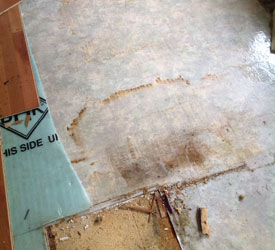This post which follows relating to How to Repair and Prevent Bathroom Water Damage is incredibly enjoyable. Read it for your own benefit and see what you think of it.

The washroom is very susceptible for wet build-up as well as potential water damages because of the frequent use of water in it. This article supplies basic inspection strategies to assist detecting water damages hazards.
The constant use of water in the shower room makes it extremely susceptible for wet build-up and also potential water damages. By inspecting it on a regular basis, you can reduce water associated problems.
The following collection of inspections is simple to do as well as need to be done once in every 3 months in order to maintain your restroom healthy and to prevent prospective water problems brought on by the bath tub, the shower, pipe joints and plumbing, sinks, cupboards, and also the commode
Do not neglect performing these evaluations as well as be complete while executing them. Remember that these simple evaluations can save you a lot of money by supplying very early signs for water damages
Bath tub and Shower
The shower and bath tub need special attention and upkeep. Inspect the ceramic tiles and change if split. Make certain that there is no missing grout in between the floor tiles. Check as well as replace broken caulking at joints where the walls meet the flooring or the bath tub. Blocked drains and pipes troubles will certainly avoid the bathtub from drying out and also might show severe issues underneath the tub. Speak with an expert instantly to prevent structural damage. Focus on stainings or soft locations around the tub wall surfaces as they may suggest an interior leak.
Plumbing
Signs for water damage are difficult to spot because most pipelines are installed inside the walls.
Pay special interest to floor covering and also walls wetness as well as discolorations as they might indicate an unnoticeable plumbing problem. Check wetness degrees in adjacent rooms also.
Sinks and also Cabinets
Sinks and cabinets are subjected to dampness and humidity everyday as well as are commonly overlooked. Examine consistently under the sink and on the counter top over it. Repair any type of drip in the catch as it might suggest drainpipe troubles. Check out the sink, slow draining pipelines may suggest an obstructed drain. Change sink seals if they are cracked or loosened.
The Commode
The bathroom is an at risk water junction. Check the water lines as well as look for leaks around the commode seat, in the pipe, and under the water storage tank. If you detect any type of signs of dampness on the floor around the bathroom, check for leaks in the toilet edge as well as tank seals.
Realize that hanging toilet dish deodorants raises the possibilities for obstructions.
Water Damage Signs In The Bathroom To Avoid Cleanup
Musty smell
This is one of the easiest signs to catch because musty smells are so odorous. The damp, earthy, moldy smell should be a big red flag. The smell will develop when moisture gets trapped in surfaces, and begins to facilitate mold growth. Leaking pipes under cabinets, inside walls, and behind shower fixtures will cause moisture to stay trapped and not dry, which will lead to mold growth and spread. As soon as you notice any musty smells in your bathroom, have it checked for hidden water damage and cleanup signs.
Visible mold
If the smell isn’t there to give it away, sometimes you will actually see mold growth. Finding mold in your bathroom is a serious problem, because mold is very harmful to your health. By the time mold growth is visible, it also means that water damage has already occurred and been present for some time. The only way the mold problem can be resolved is to find the source of the moisture and get it stopped. To safely and adequately remove mold, you need to have professionals handle the remediation. Do not waste any time in getting mold problems addressed, fixed, and sanitized so that you can protect you and your family from the many respiratory symptoms caused by mold exposure.
Damaged floors
Bathroom floors should be able to withstand some exposure to water while still remaining in good condition. However, when excess exposure or water leaks occur, they will begin to damage even the most water-resistant flooring. If you notice any cracking, bubbling, staining, or warping on your bathroom floors, there is probably a water leak somewhere causing the distortion. If you notice areas of the floor have become softer, or even have a spongy feeling, there is probably damage to the subfloor. Subflooring is typically made up of plywood. When plywood is exposed to water or moisture, it will absorb it. Once it has become saturated, the weight of the excess water will cause the wood to swell and soften. Check the floors in your bathroom frequently to catch any of these sings before they lead to damaged subflooring.
Changes on walls
When water leaks behind walls, it will cause changes in the drywall. Peeling plaster, blistering paint, and soggy wallpaper are all good indicators that excess water is building up behind the wall. Water leaking behind drywall will cause it to swell and be soft to the tough. If you start to notice gaps along the trim of your walls, or where tile meets the wall, it could also be a strong indicator that there is a leak behind the wall. Any changes, distortion, or damage on the walls should be evaluated as soon as you notice it to prevent further water damage and cleanup.

I was shown that report on How to Fix a Water Damage Bathroom from an associate on a different domain. Sharing is good. Helping people is fun. Thanks so much for going through it.
Prices & Booking